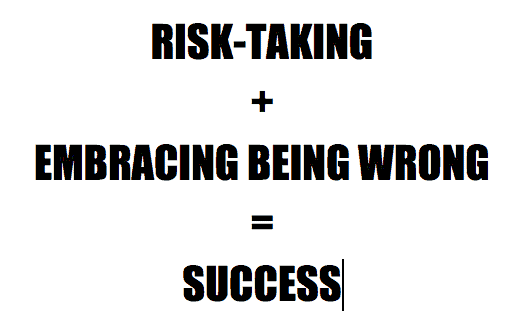Experiment and take risks to become more fluent in English
Just recently, one of my students asked me how he should go about improving his speaking. In typical blunt fashion, I responded: “You need to take risks to become more fluent in English”.
HOW IMPORTANT IS IT TO take RISKS TO BECOME MORE FLUENT IN ENGLISH?
As American linguist, H. Douglas Brown, put it in his book, Principles of Language Learning and Teaching (2006:160):
Risk-taking is an important characteristic of successful learning of a second language. Learners have to be able to gamble a bit, to be willing to try out hunches about the language and take the risk of being wrong.
Learners should not view conversation classes as a means to just react to the content of an article. In fact, they should see each conversation class as an opportunity to experiment and take chances. For instance, learners should attempt to incorporate recently learned words, collocations and grammar points into their speech.
It’s extremely motivating to take risks when speaking English, regardless of whether one is accurate or inaccurate in their execution. It’s better to be wrong than it is to be always right using the same basic structures and intermediate level vocabulary.
Just yesterday, one of my Polish students attempted to use the future perfect aspect, thus:
“in next month, we won't have been gone to the cinema for a year”
I told him that it’s unnecessary to use the future perfect because it sounds unnatural in this context. The future perfect is usually used to describe an event that’s expected or planned to occur before a point of time in the future. Therefore, it would be better to use the present perfect, thus:
It’s been almost a year since we last went to the cinema
I haven’t been to the cinema for almost a year
Overall, it’s irrelevant that his risk-taking didn’t quite pay off. He was not afraid to take on a very challenging aspect of the English grammar system. Therefore, I had to praise him for his efforts.

HOW CAN STUDENTS TAKE RISKS TO BECOME MORE FLUENT IN ENGLISH?
When it comes to individual online discussion classes, I believe that most teachers share articles and materials with students before each class. Hence, students should have time to study an article and anticipate which discussion points might come up.
I tell my students to try to predict the questions I might ask them based on the content of the article. If they’re at least well-prepared in terms of their arguments, students could shift the focus of their attention from content to the exploitation of key features found in natural fluent speech. I outlined many of these features in a post outlining the areas of English learners should focus on to attain fluency.
Language learners should focus on incorporating just one or two of these “features of fluency” into their speech per lesson. For instance, let’s assume that student Dawid keeps using pronouns with auxiliary verbs (full forms, e.g. he is) instead of the recommended contracted forms (he’s). This student uses full forms because that’s what his teacher told him to do at school. In other words, he’s the victim of that typical “formal English is correct English” attitude which infiltrates the minds of many state school English language teachers and syllabus designers.
What would I recommend this student to do?
I would tell him to write the word CONTRACTIONS! on a sticky note. He should then stick the note onto his laptop to remind himself of his “risk of the day”. There’s absolutely nothing wrong with referring to reminders when it comes to experimenting, and attempting to “defossilize” faulty habits.
PERSONALISED SENTENCES
In the same post, I wrote about the importance of creating personalised sentences with the gerund after verbs, adjectives and nouns and a preposition.
Let's return to our sticky notes again. Write three or four examples with a verb, noun or adjective + preposition + gerund structure on a sticky note. Try to create sentences using this target structure when speaking in real-life conversation. Here are three typical examples with this structure:
1. LOOK FORWARD + TO + GOING
2. PREVENT ME + FROM + DOING (STH)
3. GET USED + TO + ING
If it’s easier, you can write full sentences related to the content of an article, thus:
The type of anxiety that’s mentioned in the article certainly prevents me from getting out and meeting new people.
prevent = verb
from = preposition
getting / meeting = gerunds
Naturally, these sentences should express genuine opinions. Personalisation is central to the language learning process.
Final Thoughts
Now, you should be fully acquainted with the need to take risks to become more fluent in English.
Language lessons provide the perfect opportunity for experimentation and risk-taking.
I believe that 95% of the progress language learners make is purely down to their own efforts. The English teacher’s job should be to facilitate learning. Hence, I try to get my students to go beyond the English grammar/tense system, and explore the lexical, collocational and idiomatic side of the language by themselves.
Reference:
Brown, Douglas. 2006. Principles of Language Learning and Teaching. Fifth Edition. Pearson Education, NY: White Plains



